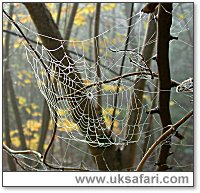
|

|
|
 Sent
to you Sent
to you
by e-mail
|
|
Simply
enter your details and hit the send button
more
info |
|


Click Here

Links
Advertise
Terms of Use
Contributors
About Us
Contact Us
|
 |
Go back
 | Bookmark
| Bookmark
 | Print Page
| Print Page  | E-Mail Us
| E-Mail Us 
How do Spiders Spin Webs?

Photo: G. Bradley
|
|
UK
Safari Tip:
A great way to see all the details on spiders and other small
creatures is with a special magnifier box - click
here
|
|
At the back of the spiders body there are three pairs of glands, each with a tube. These tubes are called spinnerets. The spider presses the spinnerets against an object and forces out some liquid silk. As the spider moves away from the object, this draws out the sticky liquid and it then hardens in the air.
To make sure the spider doesn't get caught in its own web, the spider coats its legs with an oily substance from its mouth.
Did You Know?
It has been calculated that the silk produced by spiders is so strong, that if it were woven into a thread one inch thick, it would be three times stronger than a similar rope made of iron, and could support a weight of 74 tons!

What is a Spider?
Why are Orb Web Spider Webs Shaped like that?
Is This a Deadly Spider?
Flying Spiders!
UK Safari Spider Section
 Spiders
of Britain and N. Europe
Spiders
of Britain and N. Europe
The ultimate field guide to spiders. A must for all arachnophiles everywhere.
Superbly illustrated.
|
 |

|